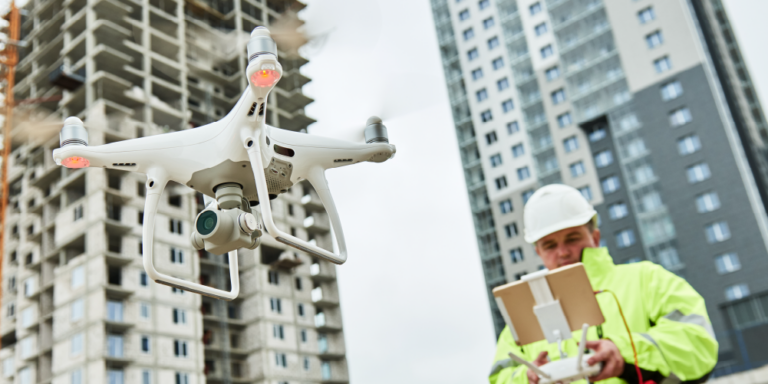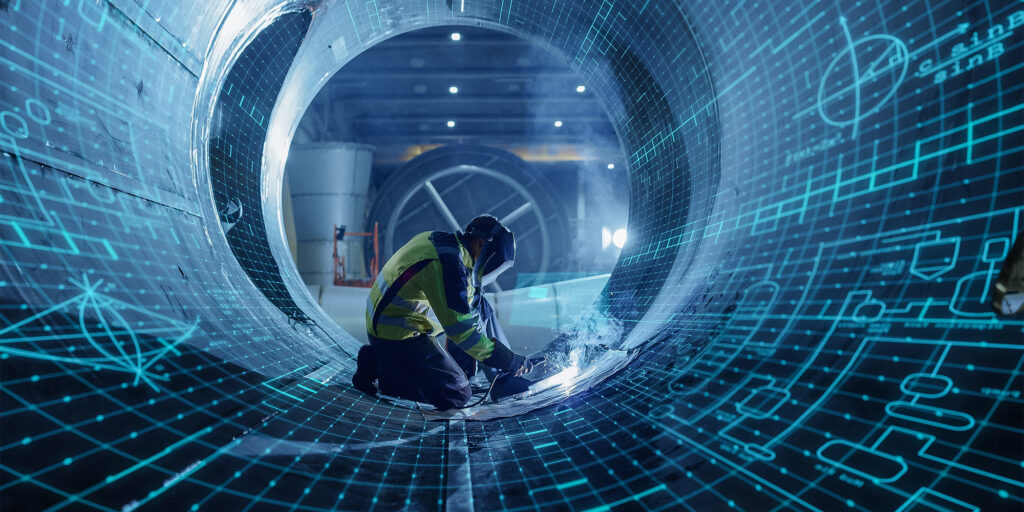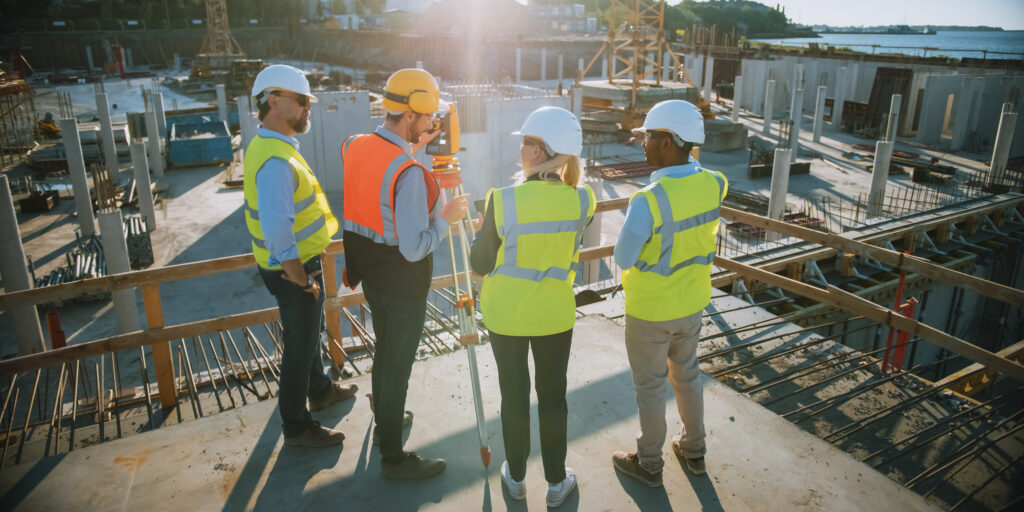— 8 min read
Innovation in Construction: Best Practices for Implementing New Tools
Last Updated Sep 19, 2024
Last Updated Sep 19, 2024

Innovation in construction is often synonymous with adopting a growing list of tech products that promise to revolutionize the job site. Certainly, there are many technologies that can change how to design, build and manage projects. But innovation is available to anyone, and it doesn’t have to be complicated or expensive.
Innovation in construction is any tool, method or habit that optimizes the construction process and improves final outcomes. Innovations can include mindblowing new technologies that change how work is done or simple improvements that make a workplace safer and more efficient.
This article explores construction innovation, including the mindsets and culture necessary to implement innovation and best practices for overcoming common challenges.
Table of contents
The Origins of Innovation
Innovations are changes made to improve the process of designing a project, managing it or the project’s final state. Some of the common ways innovation occurs include:
- Technology: such as Building Information Modeling (BIM) or the use of drones
- Processes and methodologies: such as lean construction methods, just-in-time deliveries or using document management tools such as Procore for common workflows such as requests for information (RFI) or change orders.
- Materials: such as prefabricated roof trusses or high-strength steel.
- Sustainability practices: such as smart water sensors or using construction telematics to monitor energy usage.
- Safety protocols: such as improved training videos or using 3D modeling to identify potential risks.
- Data: such as analytics measuring completion times or key performance indicators (KPIs) to assess the financial health of a company or a project.
Generally, the construction industry consists of people who care about delivering quality products and finding ways to be successful on tight timelines and budgets. However, much of the industry has also been resistant to adopting advanced technologies because of the cost, time and other risks associated with investing in and implementing them. That’s rapidly changing, as designers, builders and owners regularly face serious concerns about the environment, the market, and the availability of resources.
A lot of technology has also become easier to access and more affordable, while improvements in data collection and analysis have made it easier to assess its efficacy.
Importance of Innovation in Construction
Innovation should solve problems and create new possibilities. The potential that can be unlocked is as varied as the problems and inefficiencies that exist. Here are a few common goals innovation can help people pursue:
| Potential goal | Examples |
| Optimization: Make existing processes more efficient, productive, or cost-effective. | - More precise planning methods, such as pull planning - Organized document management tools to collect closeout documents throughout construction - Improved systems for invoicing |
| Advancement: Do things that weren’t previously possible. | - 3D modeling for prototyping - Drones for surveying |
| Sustainability: Reduce a project’s environmental impact. | - Renewable energy such as solar panels - Water reclamation systems |
| Safety: Reduce the risk of accident or injury. | - Predictive analytics to identify risks - Digital daily logs for routine inspections that assign tasks to appropriate stakeholder - Augmented or virtual reality for training |
| Collaboration: Improve communication, streamline working together and better navigate competing priorities. | - Improved workflows, such as RFIs, change orders or submittals - Organized communication systems that sort and file all interactions related to each job |
| Optimization: Make existing processes more efficient, productive, or cost-effective. | Problem-solving: Predict and address problems, ranging from an issue of constructability to labor shortages. |
7 Innovative Construction Tools and Methods
Innovation isn’t limited to advanced technology, but tech is often the most prominent and profound type of innovation. Here are 7 innovations that can change the construction process, ranging from easy to implement and free to highly technological and extremely expensive.
1. Lean Construction Methods
Lean construction is a methodology that transitions the focus of planning to the management and design of construction processes as opposed to just the end product. This can maximize stakeholder value, minimize waste and create a dynamic and collaborative work environment that increases productivity and stakeholder investment.
2. Document Management Software
Construction has always required managing an extraordinary amount of documents. In the past, the industry relied on writing things down, collecting and recording all interactions, seeking out information by visiting the site trailer and keeping track of all changes to schedules or drawings.
Digital document management programs allow people to store all important documents and communication in one place. This makes processes like collecting closeout documents easier while also reducing overall costs by making expenses easier to track, issues easier to resolve and minimizing rework.
3. Cost Estimator Tools
There are many tools to improve the estimation process in construction. Many software programs, including Procore, have improved cost management and tracking features that make estimates more precise and can use data from previous jobs to improve future estimates. Some estimating software provides up-to-date cost information for materials, labor and equipment in specific areas. Many tools, including BIM, use takeoffs, which is the process of using specific drawings and plans to create more accurate estimates for materials and equipment.
4. BIM
BIM technology helps create virtual models of structures before construction begins. These in-depth models can be analyzed and revised to reduce rework and costs on the actual project. BIM solutions have historically been difficult to use and inaccessible, but improvements are making them increasingly crucial for complex or tight-trodden projects.
5. Prefabricated Construction
Prefab construction involves manufacturing or assembling components at a separate location and then being delivered to the worksite. Common prefab components include roof and floor trusses, wall panels, bridge components, drainage systems for water and wastewater projects and steel framing. Prefabrication can decrease costs, create materials that are extremely precise and reduce the need for onsite storage or assembly.
6. Robotics
Robotics covers a wide range of new technologies that are changing how construction work is done. Robotics often refers to the use of automated machines to complete repeatable tasks. This can help save costs, speed up construction and improve jobsite safety. Robotics also includes drones for inspections and surveys or tools used to create prefabricated elements.
7. Construction Telematics
Construction telematics is a system of devices that collect and analyze data from equipment and machinery. This could include data such as fuel usage, total usage time, idling time and diagnostic information. Tracking the usage and performance of equipment can increase efficiency, improve safety and lengthen the life of machinery.
Implementing New Innovations: Best Practices
Deciding on and implementing innovations can be tricky. Here are a few best practices to increase the likelihood that a new tool or methodology leads to improved outcomes.
Cultivate positive mindsets and culture.
The success of most innovations depends less on the innovation itself, and more on the culture and mindsets of the people using it. Simply demanding people use a new tool rarely results in a desirable outcome. Teams that have a shared goal of creating excellent work, feel like they’re part of problem-solving and value communication and safety are more likely to try new technology and methods. This openness also means they can help identify areas of improvement and give feedback on how to better use new innovations.
Keep innovating.
Innovation doesn’t have to be expensive: It can be as simple as identifying areas of the construction process that can be improved and finding ways to do that. This can include the hottest new technology that’s extremely expensive, but it doesn’t have to. Data collecting and analysis, improved training and efficient document management systems are examples of inexpensive changes that can shift an organization’s culture and improve outcomes.
Address resistance and misunderstandings with personal connection.
People fear what they don’t know. Even more, they fear what they’ve been told will replace them, as is often the case with AI. One of the best ways to address these types of anxieties is through personal connection. In most cases, innovations are meant to help people do their job more effectively. Taking time to explain that and to understand concerns and questions can help create plans of implementation that are more likely to be received positively.
Prioritize tasks.
Innovations can’t solve everything and they almost always come with trade-offs. A new software might improve quality but add substantial costs. A system for deliveries might decrease cost but increase waste. A planning tool might decrease the timeline but lead to miscommunications. Being clear on what issue an innovation should address and why it’s important to address can help balance these trade-offs.
Reflect and refine processes.
Most innovations require time and iterations to truly enhance the construction process. This applies to becoming fluent with a new software, learning how to use BIM or creating a new safety training. Create time for stakeholders to reflect and share feedback, so that innovations become more effective each time they’re used.
The Future of Construction
Some technological innovations have started to raise questions about the industry's future. Some people believe it won’t be long before AI designs buildings, robotics puts them together, and software manages them. In other words, a common concern is whether people are innovating themselves out of their jobs.
The industry is likely to change significantly in the next few decades. However, many of these technologies require input and oversight from human expertise and experience. Being part of creating and shaping innovation increases the likelihood that the future has a place for workers and is one where technology is a tool for getting jobs done better.
Was this article helpful?
Thank you for your submission.
100%
0%
You voted that this article was . Was this a mistake? If so, change your vote here.
Scroll less, learn more about construction.
Subscribe to The Blueprint, Procore’s construction newsletter, to get content from industry experts delivered straight to your inbox.
By clicking this button, you agree to our Privacy Notice and Terms of Service.
Categories:
Tags:
Written by
Will Cotten
As RNGD's Innovation Leader, Will Cotten incubates emerging teams, leads technology strategy, and augments the company’s capabilities —implementing new technology and supporting the development of in-house construction analytics and prefabrication capabilities. Will enables RNGD to find and apply innovative solutions that advance the company’s overall mission of “building a better world.” Drawn to the firm's unparalleled drive, exemplified by a values-oriented band of team members, Will joined RNGD in 2018 as a Commercial Operations Intern. Since then, his ingenuity and unique insight have enabled him to rise to the occasion in new positions and deliver on strategic initiatives. A native of Prairieville, Louisiana, William earned his degree in Construction Management from Louisiana State University. His work ethic has revolved around the ethos of “actions not words.” He applies that same mentality as a board member for the Palmisano Foundation. He was also recognized as 2022 BuiltWorlds Leader of Tech Adoption. Aside from spending time with family and friends, William indulges in a love for nature and the human experience. He indulges in content on evolutionary biology, human psychology, philosophy, spirituality, and has a soft spot for New Orleans history. And when he’s not in the office, you’ll likely find him outdoors — on a long walk, golfing, hiking, camping, even gardening and cutting the grass. Will was named to the 2022 BuiltWorlds Adoption Top 50 List. The people within this list are all leading the way towards innovation for their companies and the industry overall.
View profileJames Hamilton
70 articles
James Hamilton is a writer based in Brooklyn, New York with experience in television, documentaries, journalism, comedy, and podcasts. His work has been featured on VICE TV and on The Moth. James was a writer and narrator for the show, VICE News Tonight, where he won an Emmy Award and was nominated for a Peabody Award.
View profileExplore more helpful resources

Building in Balance: Technology and Well-being in Construction
The construction industry is in the midst of a culture shift driven by the technology that has revolutionized how the industry works. Digital tools and advanced software have redefined how...

Technology for Construction Safety: Strategies to Supercharge and Scale Safety Practices
The construction industry is no stranger to the arrival of new technology, and builders are realizing its many benefits. Modernization across the industry is helping contractors streamline operations, enhance efficiency,...

Measuring Success and Leveraging Metrics in Construction Technology
The implementation of construction software is supposed to be an exciting phase of tech adoption, a time when planning, evaluating and collaborating begins to yield results. However, realizing the excitement...

Construction Cybersecurity: Protecting Projects and People
From the streamlined workflows of project management software to the futuristic promises of robotics, tech is introducing opportunities that were previously unimaginable in the construction industry. But all that potential...
Free Tools
Calculators
Use our calculators to estimate the cost of construction materials for your next project.
Templates
Find a template to help you with your construction project tasks.
Material Price Tracker
Get the latest U.S. retail prices and view historical trends for common building materials.
Glossary
Explore key terms and phrases used in the industry.